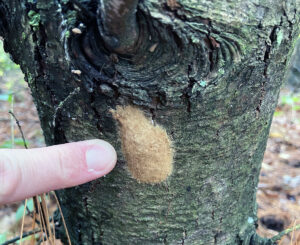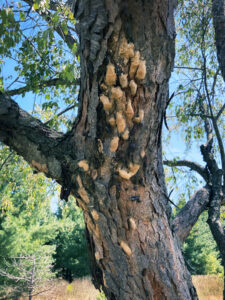
A finger points to a tan-colored spongy moth egg mass on a tree. / Photo Credit: Bill McNee, Wisconsin DNR
By Bill McNee, DNR Forest Health Specialist, Oshkosh;
Bill.McNee@wisconsin.gov or 920-360-0942
If the 2024 spring and summer weather conditions are favorable for the spongy moth (Lymantria dispar) population, the current outbreak will continue and spread to other parts of Wisconsin. Property owners are encouraged to examine susceptible host trees (including oak, birch, crabapple, aspen and willow) and make plans to manage them.
In summer 2023, Wisconsin saw a record amount of defoliation. State agencies received many calls from property owners urgently seeking a tree care business to control a large caterpillar infestation.
Arranging for an insecticide treatment can avoid a last-minute rush when pesticide application businesses are busy. Resources for finding a qualified pesticide applicator include the Wisconsin Arborist Association, the International Society of Arboriculture and the local telephone book.
Insecticide treatments are usually most effective when the caterpillars are tiny (mid to late May in southern counties; late May to early June in northern counties). Treatments done from the ground include cover sprays, soil injections and trunk injections that mitigate the risk of introducing oak wilt.

Numerous tan-colored spongy moth egg masses on a bur oak in Walworth County. / Photo Credit: Bill McNee, Wisconsin DNR
One option for treating larger, high-value tree areas is to organize an aerial spray. Planning an aerial spray can be complicated and time-consuming. We recommend that landowners begin planning now to do a timely treatment in the spring of 2024, especially when multiple property owners are involved.
An egg mass survey is the best way to predict the level of defoliation that may occur next summer. Spongy moth egg masses – tan-colored lumps about the size of a nickel or quarter – are found on trees, buildings and other outdoor objects. They may also be found in protected places like firewood piles and birdhouses. Egg masses produced in the current year will feel firm and appear darker in color than older egg masses, which appear faded, feel spongy and do not contain viable eggs.
A professional treatment is often unnecessary in areas with few egg masses or small trees. However, a professional treatment is likely needed when high numbers of egg masses are found on mature trees. Host trees enduring heavy defoliation and drought stress in 2023 are at elevated risk for mortality if defoliated in 2024 and may need insecticide protection this coming year. Subsequent infestation by twolined chestnut borer (a native beetle) will frequently occur in untreated, low-vigor oak trees. Consult an arborist or forester if you have concerns.
During the next few months, you can help reduce pest populations by treating or removing egg masses within reach. Accessible egg masses can be sprayed with horticultural oil (available online or at many home and garden centers) when temperatures are warm enough. You can also gently scrape masses into soapy water to soak for a few days before being discarded in the trash. Do not use motor oil or other lubricants, as these pollutants can harm the trees and soil. Old egg masses do not need to be oiled or removed because they no longer contain viable eggs.
Visit spongymoth.wi.gov for additional information on egg mass oiling and removal, physical controls and insecticide application. A map of quarantined counties shows where the pest is generally established.
